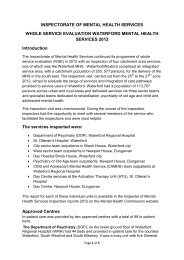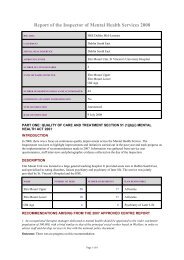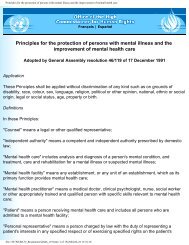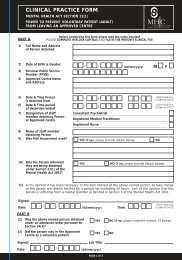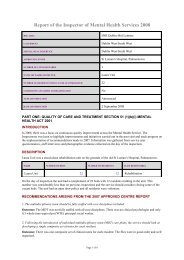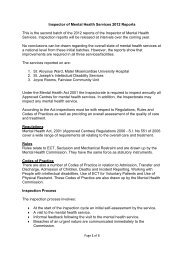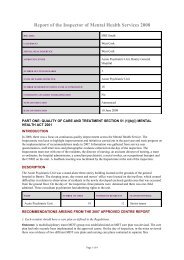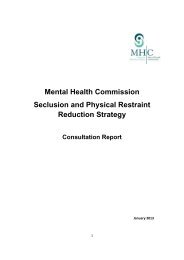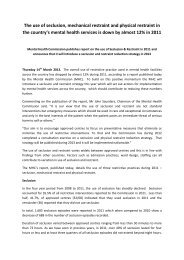LGBT Service Users - Guide for Staff in Mental Health Services
LGBT Service Users - Guide for Staff in Mental Health Services
LGBT Service Users - Guide for Staff in Mental Health Services
Create successful ePaper yourself
Turn your PDF publications into a flip-book with our unique Google optimized e-Paper software.
Lesbian, Gay, Bisexual and<br />
Transgender <strong>Service</strong> <strong>Users</strong><br />
Guidance <strong>for</strong> <strong>Staff</strong> Work<strong>in</strong>g<br />
<strong>in</strong> <strong>Mental</strong> <strong>Health</strong> <strong>Service</strong>s
Key<br />
Terms<br />
Sexual Orientation refers to<br />
an endur<strong>in</strong>g pattern of emotional,<br />
romantic, and/or sexual attractions<br />
to men, women or both sexes. Sexual<br />
orientation also refers to a person’s<br />
sense of identity based on those<br />
attractions, related behaviours and<br />
membership <strong>in</strong> a community of<br />
others who share those attractions.<br />
Three sexual orientations are<br />
commonly recognised – heterosexual,<br />
homosexual (gay and lesbian) and<br />
bisexual.<br />
Lesbian A lesbian is a woman<br />
who is romantically, sexually and/or<br />
emotionally attracted to women.<br />
Gay A gay man is one who is<br />
romantically, sexually and/or<br />
emotionally attracted to men.<br />
The word gay can be used to refer<br />
generally to lesbian, gay and bisexual<br />
people but many women prefer the<br />
word lesbian to refer to their sexual<br />
orientation. Most gay people don’t<br />
like to be referred to as homosexual<br />
because of the negative historical<br />
associations with the word.<br />
Bisexual A bisexual person is<br />
someone who is romantically, sexually<br />
and/or emotionally attracted to people<br />
of both sexes.<br />
Gender Identity refers to whether<br />
one feels male or female regardless<br />
of sex assigned at birth. Gender<br />
expression refers to outwardly<br />
express<strong>in</strong>g one’s gender identity<br />
through mannerisms, groom<strong>in</strong>g,<br />
physical characteristics, social<br />
<strong>in</strong>teractions and speech.<br />
Transgender is a term used to<br />
describe people whose gender identity<br />
or gender expression, differ from the<br />
sex assigned to them at birth. Not<br />
everyone whose feel<strong>in</strong>gs, appearance<br />
or behaviour is gender-atypical will<br />
identify as a transgender person. Many<br />
transgender people live full-time or<br />
part-time <strong>in</strong> their preferred gender.<br />
<strong>LGBT</strong> is an acronym <strong>for</strong> lesbian, gay,<br />
bisexual and transgender.<br />
Com<strong>in</strong>g Out is a term that refers to<br />
<strong>LGBT</strong> people’s discovery, acceptance<br />
and disclosure of their sexual<br />
orientation or gender identity.<br />
Heteronormativity refers to the<br />
assumption that heterosexuality and<br />
heterosexual norms are universal.<br />
Heteronormativity can manifest as<br />
the assumption that everyone is<br />
heterosexual or that lesbian, gay and<br />
bisexual orientations are a deviation<br />
from the ‘heterosexual norm’.<br />
Transsexual refers to people<br />
whose gender identity is opposite to<br />
the sex assigned to them at birth.<br />
Transsexual people may seek medical<br />
<strong>in</strong>terventions, such as hormones and<br />
surgery, to make their bodies fit as<br />
much as possible with their preferred<br />
gender. The process of chang<strong>in</strong>g<br />
from one gender to another is called<br />
transition<strong>in</strong>g. Biological females who<br />
wish to live and be recognised as<br />
men are called female-to-male (FTM)<br />
transsexuals or trans men. Biological<br />
males who wish to live and be<br />
recognised as women are called maleto-female<br />
(MTF) transsexuals or trans<br />
women. DSM-5 uses the term Gender<br />
dysphoria <strong>in</strong>stead of transsexual and<br />
this replaces the term gender identity<br />
disorder which was used <strong>in</strong> DSM-IV.<br />
Transition<strong>in</strong>g is the process of<br />
chang<strong>in</strong>g the way someone’s gender<br />
is lived publicly. People who wish to<br />
transition often start by express<strong>in</strong>g<br />
their gender identity <strong>in</strong> situations<br />
where they feel safe. They typically<br />
work up to liv<strong>in</strong>g full-time <strong>in</strong> their<br />
preferred gender by mak<strong>in</strong>g gradual<br />
changes to their gender expression.<br />
Connect<strong>in</strong>g with other transgender<br />
people through peer support<br />
groups and transgender community<br />
organisations is also very helpful <strong>for</strong><br />
people when they are go<strong>in</strong>g through<br />
the transition process. Transition<strong>in</strong>g<br />
typically <strong>in</strong>volves changes <strong>in</strong> cloth<strong>in</strong>g<br />
and groom<strong>in</strong>g, a name change, change<br />
of gender on identity documents,<br />
hormonal treatment, and surgery.
Introduction<br />
This guide has been produced by GLEN – Gay and Lesbian<br />
Equality Network – <strong>in</strong> consultation with the <strong>Mental</strong> <strong>Health</strong><br />
Commission (MHC) to provide staff work<strong>in</strong>g <strong>in</strong> mental<br />
health services with <strong>in</strong><strong>for</strong>mation to assist them <strong>in</strong> their<br />
day to day <strong>in</strong>teractions with lesbian, gay, bisexual and<br />
transgender (<strong>LGBT</strong>) people avail<strong>in</strong>g of services. The need<br />
<strong>for</strong> this guidance arose from Irish research 1 that identified<br />
<strong>in</strong>creased mental health risk among <strong>LGBT</strong> people, and<br />
younger people <strong>in</strong> particular, as well as the need to<br />
<strong>in</strong>crease awareness amongst health professionals of<br />
<strong>LGBT</strong> people’s mental health needs.<br />
The national mental health policy A Vision <strong>for</strong> Change<br />
highlighted the need <strong>for</strong> mental health services to be<br />
delivered <strong>in</strong> an <strong>in</strong>clusive manner and <strong>for</strong> <strong>LGBT</strong> people’s<br />
specific needs to be considered by those deliver<strong>in</strong>g<br />
services. While there is greater visibility and <strong>in</strong>clusion of<br />
<strong>LGBT</strong> people <strong>in</strong> Irish society <strong>in</strong> recent years, many still<br />
feel they need to hide their sexual orientation or gender<br />
identity <strong>for</strong> fear of negative reactions from people,<br />
<strong>in</strong>clud<strong>in</strong>g from service providers. Indeed, a study on <strong>LGBT</strong><br />
people’s experiences of access<strong>in</strong>g health services <strong>in</strong><br />
Ireland <strong>in</strong>clud<strong>in</strong>g mental health services found:<br />
»»<br />
76.9% of participants felt healthcare providers need<br />
to have more knowledge of and sensitivity to <strong>LGBT</strong><br />
issues;<br />
»»<br />
<strong>Health</strong>care providers were only aware of<br />
respondents’ <strong>LGBT</strong> identity <strong>in</strong> 44% of cases;<br />
»»<br />
Only 40% felt respected as an <strong>LGBT</strong> person by<br />
healthcare providers;<br />
»»<br />
45% actively sought out <strong>LGBT</strong>-friendly healthcare<br />
professionals because of bad experiences that they<br />
had with providers <strong>in</strong> the past.<br />
The MHC’s Quality Framework <strong>for</strong> <strong>Mental</strong> <strong>Health</strong> <strong>Service</strong>s<br />
(2007) provides clear guidance <strong>for</strong> service users and<br />
members of the public as to what they can expect from<br />
a mental health service. Standard 2.1 of the Quality<br />
Framework states that service users should receive<br />
services <strong>in</strong> a manner that respects and acknowledges<br />
their specific values, beliefs and experiences. In l<strong>in</strong>e<br />
with this standard, Criteria 2.1.6 of the Quality Framework<br />
highlights that “service users experience receipt of care<br />
that is <strong>in</strong> compliance with equality legislation” (p 26) and<br />
prohibits discrim<strong>in</strong>ation on grounds <strong>in</strong>clud<strong>in</strong>g sexual<br />
orientation and gender.<br />
Furthermore, Standard 5.1 of the Quality Framework<br />
states that mental health services should be accessible<br />
to the community and Criteria 5.1.1 highlights that “the<br />
mental health service ensures equality <strong>in</strong> access<strong>in</strong>g a<br />
service” (p 38) regardless of service user characteristics<br />
such as sexual orientation or gender.<br />
This guide has been developed by GLEN to assist the<br />
MHC <strong>in</strong> promot<strong>in</strong>g, encourag<strong>in</strong>g and foster<strong>in</strong>g high<br />
standards and good practices <strong>in</strong> the delivery of mental<br />
health services to <strong>LGBT</strong> people. It should be read <strong>in</strong><br />
conjunction with MHC publications such as the Quality<br />
Framework <strong>for</strong> <strong>Mental</strong> <strong>Health</strong> <strong>Service</strong>s and A Recovery<br />
Approach with<strong>in</strong> the Irish <strong>Mental</strong> <strong>Health</strong> <strong>Service</strong>s (MHC,<br />
2008). There are also a number of guidance documents<br />
developed by Irish professional bodies <strong>for</strong> mental health<br />
professionals that complement this guide (see Resources<br />
section on page 7). GLEN would like to thank the MHC <strong>for</strong><br />
their <strong>in</strong>valuable support <strong>in</strong> develop<strong>in</strong>g and distribut<strong>in</strong>g<br />
this guidance <strong>for</strong> staff work<strong>in</strong>g <strong>in</strong> mental health services.<br />
Odhrán Allen<br />
Director of <strong>Mental</strong> <strong>Health</strong><br />
Gay & Lesbian Equality Network<br />
1
Lesbian, Gay, Bisexual and Transgender <strong>Service</strong> <strong>Users</strong>: Guidance <strong>for</strong> <strong>Staff</strong> Work<strong>in</strong>g <strong>in</strong> <strong>Mental</strong> <strong>Health</strong> <strong>Service</strong>s<br />
What is<br />
the Issue<br />
A number of national policies 2,3,4,5,6 have highlighted the<br />
need <strong>for</strong> mental health professionals and healthcare<br />
providers to be more <strong>in</strong>clusive of <strong>LGBT</strong> people <strong>in</strong> their<br />
practice and to consider the specific needs of <strong>LGBT</strong><br />
people. The HSE (2009) <strong>in</strong> its report <strong>LGBT</strong> <strong>Health</strong><br />
highlighted that <strong>LGBT</strong> people experience <strong>in</strong>equities <strong>in</strong><br />
access to and with<strong>in</strong> health services which can lead to<br />
reluctance to engage with ma<strong>in</strong>stream health services.<br />
It also concluded that <strong>LGBT</strong> people are at a heightened<br />
mental health risk because of the stresses created by<br />
stigmatisation, marg<strong>in</strong>alisation and discrim<strong>in</strong>ation.<br />
Reach Out, the national suicide prevention strategy,<br />
identified <strong>LGBT</strong> people as one of a number of<br />
marg<strong>in</strong>alised groups at risk of suicidal behaviour. It<br />
highlighted the need to conduct research on <strong>LGBT</strong><br />
people’s mental health and to develop resources to<br />
improve mental health service delivery to <strong>LGBT</strong> people.<br />
The National Office <strong>for</strong> Suicide Prevention funded the<br />
Support<strong>in</strong>g <strong>LGBT</strong> Lives study, which exam<strong>in</strong>ed <strong>for</strong> the first<br />
time <strong>LGBT</strong> mental health risk and resilience <strong>in</strong> an Irish<br />
context. A key f<strong>in</strong>d<strong>in</strong>g of this study, <strong>in</strong> which 1,110 <strong>LGBT</strong><br />
people participated, was that <strong>LGBT</strong> people, and young<br />
people <strong>in</strong> particular, are at risk of suicidal behaviour<br />
related to difficulties be<strong>for</strong>e and after com<strong>in</strong>g out to their<br />
family and <strong>in</strong> school. One of the recommendations aris<strong>in</strong>g<br />
from the Support<strong>in</strong>g <strong>LGBT</strong> Lives report was that the<br />
<strong>Mental</strong> <strong>Health</strong> Commission ensures that mental health<br />
service standards <strong>in</strong>clude care policies <strong>for</strong> <strong>LGBT</strong> people.<br />
This guidance document has been developed by GLEN<br />
<strong>in</strong> consultation with the <strong>Mental</strong> <strong>Health</strong> Commission to<br />
provide staff work<strong>in</strong>g <strong>in</strong> mental health services with<br />
<strong>in</strong><strong>for</strong>mation to assist them <strong>in</strong> their day to day <strong>in</strong>teractions<br />
with <strong>LGBT</strong> people avail<strong>in</strong>g of services. It also aims to<br />
improve service providers’ knowledge of and sensitivity to<br />
<strong>LGBT</strong> issues.<br />
Some of the key f<strong>in</strong>d<strong>in</strong>gs related to ‘com<strong>in</strong>g out’, mental<br />
health and suicidality from the Support<strong>in</strong>g <strong>LGBT</strong> Lives<br />
study are presented below which give an <strong>in</strong>sight <strong>in</strong>to the<br />
specific experiences of <strong>LGBT</strong> people <strong>in</strong> Ireland.<br />
2
Key F<strong>in</strong>d<strong>in</strong>gs of the ‘Support<strong>in</strong>g<br />
<strong>LGBT</strong> Lives’ Study<br />
‘Com<strong>in</strong>g Out’<br />
»»<br />
12 years of age = the most common age to realise<br />
one’s <strong>LGBT</strong> identity<br />
»»<br />
17 years of age = the most common age to first<br />
disclose one’s <strong>LGBT</strong> identity to anyone<br />
»»<br />
5 years = the most common number of years that<br />
young <strong>LGBT</strong> people conceal their identity from<br />
others. This 5 year period co<strong>in</strong>cides with puberty,<br />
school and a critical period of social, emotion and<br />
vocational development<br />
»»<br />
The period prior to com<strong>in</strong>g out was particularly<br />
stressful because of fear of rejection (by parents<br />
<strong>in</strong> particular) and because of isolation<br />
»»<br />
The majority came out to a friend or another trusted<br />
<strong>in</strong>dividual be<strong>for</strong>e com<strong>in</strong>g out to their family. Friends<br />
and family, but parents <strong>in</strong> particular, have a crucial<br />
role to play <strong>in</strong> support<strong>in</strong>g <strong>LGBT</strong> people as they come<br />
out and this support can act as a protective buffer<br />
aga<strong>in</strong>st specific stresses <strong>LGBT</strong> young people may<br />
encounter such as homophobic bully<strong>in</strong>g <strong>in</strong> school<br />
<strong>LGBT</strong> <strong>Mental</strong> <strong>Health</strong> and Suicidality<br />
»»<br />
27% had self-harmed and 85% of these did so more<br />
than once<br />
»»<br />
16 years was the average age of first self-harm<strong>in</strong>g<br />
»»<br />
40% of females and 20% of males had self-harmed<br />
»»<br />
18% had attempted suicide and 85% saw their first<br />
attempt as related to stresses associated with their<br />
<strong>LGBT</strong> identity (e.g. fear of rejection by family or<br />
friends)<br />
»»<br />
17.5 years was the average age of first suicide<br />
attempt<br />
»»<br />
24% of females and 15% of males attempted<br />
suicide at least once<br />
»»<br />
Over a third of those aged 25 years and under had<br />
thought seriously about end<strong>in</strong>g their lives with<strong>in</strong> the<br />
past year and over 50% had done so at some time<br />
»»<br />
The 3 most common <strong>LGBT</strong>-specific stresses<br />
identified were:<br />
· fear of rejection when consider<strong>in</strong>g com<strong>in</strong>g out;<br />
· negative school experiences; and<br />
· experiences of harassment and victimisation<br />
SUPPORTING <strong>LGBT</strong> LIVES:<br />
A STUDY OF THE MENTAL HEALTH AND WELL-BEING OF LESBIAN,<br />
GAY, BISEXUAL AND TRANSGENDER PEOPLE<br />
Key F<strong>in</strong>d<strong>in</strong>gs<br />
3
Lesbian, Gay, Bisexual and Transgender <strong>Service</strong> <strong>Users</strong>: Guidance <strong>for</strong> <strong>Staff</strong> Work<strong>in</strong>g <strong>in</strong> <strong>Mental</strong> <strong>Health</strong> <strong>Service</strong>s<br />
What can mental<br />
health staff do<br />
The follow<strong>in</strong>g guidance has been structured under the<br />
themes of the MHC Quality Framework <strong>for</strong> <strong>Mental</strong> <strong>Health</strong><br />
<strong>Service</strong>s. It outl<strong>in</strong>es the steps that those work<strong>in</strong>g <strong>in</strong> and<br />
provid<strong>in</strong>g mental health services can take to ensure that<br />
services are provided <strong>in</strong> an <strong>in</strong>clusive way to <strong>LGBT</strong> service<br />
users as well as their partners and families/chosen<br />
advocates.<br />
Theme 1:<br />
Provision of a holistic seamless service and<br />
the full cont<strong>in</strong>uum of care provided by a<br />
multidiscipl<strong>in</strong>ary team<br />
»»<br />
All mental health services are likely to have <strong>LGBT</strong><br />
service users and/or family members or parents<br />
of services users who are <strong>LGBT</strong>. In a recent national<br />
study approximately 8% of people identified as<br />
lesbian, gay or bisexual there<strong>for</strong>e it follows that<br />
a similar percentage of mental health service users<br />
are <strong>LGBT</strong> 7 .<br />
»»<br />
Identify specific needs. A person’s <strong>LGBT</strong> identity<br />
may be unrelated to their need <strong>for</strong> the service.<br />
For some their experiences as an <strong>LGBT</strong> person<br />
will be closely related to their presentation.<br />
There<strong>for</strong>e, <strong>in</strong> addition to rout<strong>in</strong>e assessment<br />
and treatment, where appropriate, consider the<br />
role of <strong>LGBT</strong>-specific stresses <strong>in</strong> the person’s<br />
presentation to services, <strong>in</strong>clud<strong>in</strong>g question<strong>in</strong>g<br />
their own sexual orientation/gender identity,<br />
fear of com<strong>in</strong>g out, lack of support after com<strong>in</strong>g out<br />
or, <strong>for</strong> those who are already ‘out’, experiences such<br />
as homophobic or transphobic bully<strong>in</strong>g. See the Key<br />
<strong>LGBT</strong> <strong>Mental</strong> <strong>Health</strong> Issues section on page 6 <strong>for</strong><br />
more <strong>in</strong><strong>for</strong>mation.<br />
»»<br />
Tra<strong>in</strong><strong>in</strong>g on <strong>LGBT</strong> issues is available from a range<br />
of groups (see list of <strong>LGBT</strong> Organisations and<br />
<strong>Service</strong>s <strong>in</strong> Resources section). An empower<strong>in</strong>g<br />
approach to the care and treatment of <strong>LGBT</strong> service<br />
users will be based on mental health staff be<strong>in</strong>g<br />
aware of their specific needs and the range of <strong>LGBT</strong><br />
community resources and organisations that can be<br />
used <strong>in</strong> recovery programmes.<br />
Theme 2:<br />
Respectful, empathic relationships are<br />
required between people us<strong>in</strong>g the mental<br />
health service and those provid<strong>in</strong>g them<br />
»»<br />
Provide an <strong>LGBT</strong>-<strong>in</strong>clusive service. This is a service<br />
that is respectful of and values both its <strong>LGBT</strong> service<br />
users and service providers.<br />
»»<br />
Respond supportively when service users disclose<br />
they are <strong>LGBT</strong>. Where appropriate ask the person<br />
about their experience of com<strong>in</strong>g out and if there are<br />
any issues related to be<strong>in</strong>g <strong>LGBT</strong> that they would like<br />
to discuss or need help with.<br />
»»<br />
Familiarise yourself with <strong>LGBT</strong> issues.<br />
<strong>LGBT</strong> specific stressors that can impact on mental<br />
health, <strong>in</strong>clude difficulties be<strong>for</strong>e or after com<strong>in</strong>g<br />
out, isolation, homophobic or transphobic bully<strong>in</strong>g<br />
and lack of family support. More <strong>in</strong>-depth <strong>in</strong><strong>for</strong>mation<br />
on these and other issues is available <strong>for</strong> mental<br />
health professionals (see <strong>Guide</strong>l<strong>in</strong>es <strong>for</strong> Professionals<br />
<strong>in</strong> Resources section).<br />
»»<br />
Recognise when work<strong>in</strong>g with young people<br />
that issues related to sexual orientation or gender<br />
identity can play a role <strong>in</strong> young people’s presentation<br />
with emotional and behavioural difficulties. This is<br />
particularly important <strong>for</strong> those work<strong>in</strong>g <strong>in</strong> Child and<br />
Adolescent <strong>Mental</strong> <strong>Health</strong> <strong>Service</strong>s (See MHC<br />
resources <strong>for</strong> further guidance on work<strong>in</strong>g with<br />
young people).<br />
»»<br />
Recognise when work<strong>in</strong>g with older people<br />
that older <strong>LGBT</strong> people may have fears and anxieties<br />
related to historical approaches to <strong>LGBT</strong> people and<br />
their relationships.<br />
Theme 3:<br />
An empower<strong>in</strong>g approach to service delivery<br />
is beneficial to both people us<strong>in</strong>g the<br />
service and those provid<strong>in</strong>g it<br />
»»<br />
Respect the rights of <strong>LGBT</strong> service users.<br />
Do not discrim<strong>in</strong>ate on the basis of sexual orientation<br />
or gender identity. This is an important component<br />
<strong>in</strong> provid<strong>in</strong>g an <strong>in</strong>clusive mental health service that<br />
respects the rights of <strong>LGBT</strong> service users.<br />
4
»»<br />
Use language and questions that reflect openness;<br />
it is important not to assume heterosexuality and<br />
recognise that gender identity may differ from<br />
presentation<br />
»»<br />
Offer person-centred care which focuses on self<br />
determ<strong>in</strong>ation and empower<strong>in</strong>g relationships based<br />
on trust, understand<strong>in</strong>g, respect and mean<strong>in</strong>gful<br />
roles <strong>in</strong> society.<br />
Theme 4:<br />
A quality physical environment that<br />
promotes good health and upholds the<br />
security and safety of service users<br />
»»<br />
Display <strong>LGBT</strong> <strong>in</strong><strong>for</strong>mation. Display<strong>in</strong>g an <strong>LGBT</strong><br />
poster or <strong>in</strong>clud<strong>in</strong>g <strong>LGBT</strong> people’s views and<br />
experiences <strong>in</strong> service literature can help create a<br />
friendly welcom<strong>in</strong>g environment <strong>for</strong> <strong>LGBT</strong> service<br />
users.<br />
»»<br />
Create a Safe Environment. <strong>Staff</strong> <strong>in</strong> <strong>in</strong>patient and<br />
residential mental health services should be<br />
m<strong>in</strong>dful of the safety and security of <strong>LGBT</strong><br />
<strong>in</strong>dividuals who may be subjected to negative<br />
comments or behaviour related to their <strong>LGBT</strong><br />
identity from other service users.<br />
Theme 5:<br />
Access to services<br />
»»<br />
Equal access. <strong>Mental</strong> health services must ensure<br />
equality <strong>in</strong> access to their service regardless of the<br />
service user’s gender, sexual orientation, civil<br />
status, family status, age, disability, ethnicity,<br />
social class, religion or membership of the traveller<br />
community.<br />
»»<br />
Include <strong>LGBT</strong> people <strong>in</strong> the service ethos statement<br />
or equality policy. This demonstrates equality of<br />
access <strong>for</strong> all service users <strong>in</strong>clud<strong>in</strong>g <strong>LGBT</strong> people.<br />
Theme 6:<br />
Family/chosen advocate <strong>in</strong>volvement and<br />
support<br />
»»<br />
Treat same-sex civil partnered or co-habit<strong>in</strong>g<br />
couples <strong>in</strong> the same way as you would married or<br />
co-habit<strong>in</strong>g heterosexual couples <strong>in</strong> the context of<br />
their legal rights and entitlements (e.g. next of k<strong>in</strong>).<br />
This is required <strong>in</strong> l<strong>in</strong>e with Equal Status legislation.<br />
»»<br />
Involve advocates where acceptable to the person.<br />
For some <strong>LGBT</strong> people, particularly those who have<br />
no contact with their family of orig<strong>in</strong>, their advocates<br />
may <strong>in</strong>clude friends or staff from <strong>LGBT</strong> services.<br />
Theme 7:<br />
<strong>Staff</strong> skills, expertise and morale are key<br />
<strong>in</strong>fluencers <strong>in</strong> the delivery of a quality<br />
mental health service<br />
»»<br />
A similar percentage of staff work<strong>in</strong>g <strong>in</strong> mental<br />
health services are likely to be <strong>LGBT</strong> <strong>in</strong> the same way<br />
that approximately 8% of service users are <strong>LGBT</strong>.<br />
»»<br />
Provide <strong>LGBT</strong> awareness tra<strong>in</strong><strong>in</strong>g <strong>for</strong> staff as this<br />
can build their capacity to best meet the needs of<br />
<strong>LGBT</strong> service users.<br />
»»<br />
Make available exist<strong>in</strong>g guidance. Guidance <strong>for</strong><br />
mental health professionals has been developed by<br />
a number of professional bodies <strong>in</strong>clud<strong>in</strong>g the<br />
College of Psychiatry of Ireland, the Irish Institute<br />
of <strong>Mental</strong> <strong>Health</strong> Nurs<strong>in</strong>g and the Irish Association<br />
of Social Workers (see Resources on page 7).<br />
Theme 8:<br />
Systematic evaluation and review of<br />
mental health services underp<strong>in</strong>ned by<br />
best practice, will enable providers to<br />
deliver quality services<br />
»»<br />
<strong>LGBT</strong> issues should be considered by the mental<br />
health service when develop<strong>in</strong>g policy and services<br />
and <strong>LGBT</strong> service users should be consulted <strong>in</strong><br />
service evaluation.<br />
»»<br />
Engagement with <strong>LGBT</strong> community groups may<br />
facilitate <strong>LGBT</strong> service user <strong>in</strong>volvement.<br />
»»<br />
Provide <strong>in</strong><strong>for</strong>mation, advice and support to the<br />
partners of <strong>LGBT</strong> service users <strong>in</strong> the same way<br />
as you would to the spouses/partners of<br />
heterosexual people.<br />
5
Lesbian, Gay, Bisexual and Transgender <strong>Service</strong> <strong>Users</strong>: Guidance <strong>for</strong> <strong>Staff</strong> Work<strong>in</strong>g <strong>in</strong> <strong>Mental</strong> <strong>Health</strong> <strong>Service</strong>s<br />
SUMMARY OF Key<br />
<strong>LGBT</strong> <strong>Mental</strong><br />
<strong>Health</strong> Issues<br />
In addition to rout<strong>in</strong>e mental health assessment and<br />
treatment, where appropriate, consider the follow<strong>in</strong>g with<br />
<strong>LGBT</strong> service users:<br />
M<strong>in</strong>ority Stress describes the mental health<br />
consequences of stigmatisation and harassment that<br />
members of m<strong>in</strong>ority groups such as <strong>LGBT</strong> people may face<br />
and the <strong>in</strong>creased risk of psychological distress associated<br />
with these experiences. A significant body of research has<br />
demonstrated that m<strong>in</strong>ority stress results <strong>in</strong> <strong>in</strong>creased risk<br />
of suicidal behaviour and self-harm among <strong>LGBT</strong> people as<br />
well as <strong>in</strong>creased risk of depression, anxiety and substance<br />
misuse 8 .<br />
Com<strong>in</strong>g Out refers to <strong>LGBT</strong> people’s discovery,<br />
acceptance and disclosure of their sexual orientation or<br />
gender identity. Most <strong>LGBT</strong> people now have a positive<br />
experience of com<strong>in</strong>g out and the support of family, friends<br />
and colleagues is critical to this. Enquire if the service user<br />
has come out to family and friends If yes, enquire if family<br />
and friends are supportive If no, explore what supports<br />
the person could benefit from<br />
Fear of Rejection Irish research 1 has shown that the<br />
majority of <strong>LGBT</strong> people report the period prior to com<strong>in</strong>g<br />
out is a particularly stressful one because of fear of<br />
rejection and isolation. For young people <strong>in</strong> particular<br />
stresses related to com<strong>in</strong>g out are strongly associated with<br />
<strong>in</strong>creased risk of depression, self-harm and attempted<br />
suicide.<br />
Disclosure Irish research 1 also tells us that the most<br />
common age that <strong>LGBT</strong> people discover their <strong>LGBT</strong> identity<br />
is age 12 and the most common age that they first disclose<br />
this to anyone is age 17. This <strong>in</strong>dicates that <strong>for</strong> most there<br />
is a 5 year period where <strong>LGBT</strong> young people conceal their<br />
identity from family and friends and this period co<strong>in</strong>cides<br />
with puberty, school and a critical period of social, emotion<br />
and vocational development <strong>in</strong> their lives.<br />
Homophobic and Transphobic Bully<strong>in</strong>g<br />
Significant numbers of <strong>LGBT</strong> students experience<br />
homophobic or transphobic bully<strong>in</strong>g <strong>in</strong> school and some<br />
adults still experience it <strong>in</strong> the workplace. This can result <strong>in</strong><br />
psychological distress and feel<strong>in</strong>gs of isolation and this is<br />
particularly true <strong>for</strong> people becom<strong>in</strong>g aware of their <strong>LGBT</strong><br />
identity at a younger age, which is <strong>in</strong>creas<strong>in</strong>gly common.<br />
Resilience Irish research 1 has identified factors that<br />
contribute to <strong>LGBT</strong> mental health resilience. Social sources<br />
of resilience <strong>in</strong>clude accept<strong>in</strong>g family, supportive friends,<br />
contact with an <strong>LGBT</strong> community group and positive<br />
experiences of school or work. Personal sources of<br />
resilience <strong>in</strong>clude <strong>for</strong>m<strong>in</strong>g a positive <strong>LGBT</strong> identity, good<br />
self-esteem, positive turn<strong>in</strong>g po<strong>in</strong>ts and develop<strong>in</strong>g positive<br />
cop<strong>in</strong>g strategies.<br />
<strong>LGBT</strong>-Specific Support An <strong>LGBT</strong>-<strong>in</strong>clusive mental<br />
health service is one that is <strong>LGBT</strong>-affirmative and provides<br />
<strong>LGBT</strong> service users with appropriate support. Remember<br />
that <strong>LGBT</strong> service users may also benefit from referral to<br />
<strong>LGBT</strong> organisations or an <strong>LGBT</strong> Helpl<strong>in</strong>e <strong>for</strong> specific support<br />
and <strong>in</strong><strong>for</strong>mation (see the Resources section).<br />
Transition<strong>in</strong>g This is the process of chang<strong>in</strong>g the way<br />
someone’s gender is lived publicly. Transition<strong>in</strong>g typically<br />
<strong>in</strong>volves changes <strong>in</strong> cloth<strong>in</strong>g and groom<strong>in</strong>g, a name change,<br />
change of gender on identity documents, hormonal<br />
treatment and surgery. The WPATH Standards of Care <strong>for</strong><br />
the <strong>Health</strong> of Transsexual and Transgender People provide<br />
specific guidance <strong>for</strong> professionals on transition<strong>in</strong>g (see<br />
Resources section). The Transgender Equality Network<br />
Ireland (TENI) provides support and <strong>in</strong><strong>for</strong>mation to<br />
transgender people and their families (see Resources<br />
section on page 7).<br />
6
What Resources are available<br />
<strong>Guide</strong>l<strong>in</strong>es <strong>for</strong><br />
Professionals on Sexual<br />
Orientation<br />
Lesbian, Gay and Bisexual Patients:<br />
The Issues <strong>for</strong> <strong>Mental</strong> <strong>Health</strong> Practice<br />
College of Psychiatry of Ireland, 2010<br />
Available at: www.glen.ie/attachments/<br />
CPsychI_LGB_<strong>Mental</strong>_<strong>Health</strong>_<strong>Guide</strong>.PDF<br />
Gay, Lesbian and Bisexual People:<br />
A Good Practice <strong>Guide</strong> <strong>for</strong> <strong>Mental</strong><br />
<strong>Health</strong> Nurses<br />
Irish Institute of <strong>Mental</strong> <strong>Health</strong><br />
Nurs<strong>in</strong>g, 2010<br />
Available at: www.glen.ie/attachments/<br />
IIMHN_LGB_<strong>Mental</strong>_<strong>Health</strong>_<strong>Guide</strong>.PDF<br />
Lesbian, Gay and Bisexual People:<br />
A <strong>Guide</strong> to Good Practice <strong>for</strong><br />
Social Workers<br />
Irish Association of Social<br />
Workers, 2011<br />
Available at: www.glen.ie/attachments/<br />
IASW_LGB_<strong>Mental</strong>_<strong>Health</strong>_<strong>Guide</strong>.PDF<br />
Lesbian, Gay and Bisexual<br />
Clients: A Good Practice <strong>Guide</strong> <strong>for</strong><br />
Psychologists<br />
Psychological Society of Ireland,<br />
2013 (<strong>for</strong>thcom<strong>in</strong>g)<br />
Appropriate Therapeutic Responses<br />
to Sexual Orientation<br />
American Psychological<br />
Association, 2009<br />
Available at: www.apa.org/pi/lgbt/<br />
resources/therapeutic-response.pdf<br />
<strong>Guide</strong>l<strong>in</strong>es <strong>for</strong><br />
Professionals on Gender<br />
Identity<br />
Standards of Care <strong>for</strong> the <strong>Health</strong> of<br />
Transsexual and Transgender People<br />
World Professional Association <strong>for</strong><br />
Transgender <strong>Health</strong>, 2011<br />
Available at: www.wpath.org/<br />
publications_standards.cfmpublications_<br />
standards.cfm<br />
Guidance <strong>for</strong> GPs and <strong>Health</strong><br />
Professionals on the Care of Gender<br />
Variant People<br />
Gender Identity Research and<br />
Education Society, 2008<br />
Available at: www.gires.org.uk/assets/<br />
DOH-Assets/pdf/doh-guidel<strong>in</strong>es-<strong>for</strong>cl<strong>in</strong>icians.pdf<br />
Irish <strong>LGBT</strong> Research &<br />
Reports<br />
Support<strong>in</strong>g <strong>LGBT</strong> Lives: A Study of<br />
the <strong>Mental</strong> <strong>Health</strong> and Well-Be<strong>in</strong>g of<br />
<strong>LGBT</strong> People<br />
Mayock, Bryan, Carr & Kitch<strong>in</strong>g, 2009<br />
Available at: www.glen.ie/attachments/<br />
Support<strong>in</strong>g_<strong>LGBT</strong>_Lives_Report.PDF<br />
Visible Lives: Identify<strong>in</strong>g the<br />
Experiences and Needs of Older <strong>LGBT</strong><br />
People <strong>in</strong> Ireland<br />
Higg<strong>in</strong>s, Sharek, McCann, Sheer<strong>in</strong>,<br />
Glacken, Breen & McCarron, 2011<br />
Available at: www.glen.ie/attachments/<br />
Visible_Lives_Report.PDF<br />
PAGE 1<br />
ma<strong>in</strong> report<br />
Visible Lives<br />
IdentIfyIng the experIences and needs<br />
of older lesbIan, gay, bIsexual and<br />
transgender people In Ireland<br />
<strong>LGBT</strong> <strong>Health</strong>: Towards Meet<strong>in</strong>g the<br />
<strong>Health</strong>care Needs of <strong>LGBT</strong> People<br />
<strong>Health</strong> <strong>Service</strong> Executive, 2009<br />
Available at: www.glen.ie/attachments/<br />
HSE_<strong>LGBT</strong>_<strong>Health</strong>_Report.PDF<br />
Resources <strong>for</strong> <strong>Service</strong><br />
<strong>Users</strong> & Families<br />
Answers to Your Questions <strong>for</strong> a<br />
Better Understand<strong>in</strong>g of Sexual<br />
Orientation<br />
American Psychological<br />
Association, 2008<br />
Available at: www.apa.org/topics/<br />
sexuality/sorientation.pdf<br />
Answers to Your Questions about<br />
Transgender People and Gender<br />
Identity<br />
American Psychological<br />
Association, 2011<br />
Available at: www.apa.org/topics/<br />
sexuality/transgender.pdf<br />
Look After Yourself, Look After Your<br />
<strong>Mental</strong> <strong>Health</strong>: In<strong>for</strong>mation <strong>for</strong> <strong>LGBT</strong><br />
People<br />
NOSP, GLEN & BeLonG To, 2010<br />
Available at: www.glen.ie/attachments/<br />
NOSP_<strong>Mental</strong>_<strong>Health</strong>_<strong>Guide</strong>_<strong>for</strong>_<strong>LGBT</strong>_<br />
People.PDF<br />
7
Lesbian, Gay, Bisexual and Transgender <strong>Service</strong> <strong>Users</strong>: Guidance <strong>for</strong> <strong>Staff</strong> Work<strong>in</strong>g <strong>in</strong> <strong>Mental</strong> <strong>Health</strong> <strong>Service</strong>s<br />
Cop<strong>in</strong>g with the Death of Your<br />
Same-Sex Partner<br />
Irish Hospice Foundation<br />
& GLEN, 2012<br />
Available at: www.glen.ie/attachments/<br />
Same-Sex_Partner_Bereavement_<br />
Leaflet.PDF<br />
<strong>LGBT</strong> <strong>Mental</strong> <strong>Health</strong> Website<br />
www.lgbtmentalhealth.ie<br />
BeLonG To <strong>LGBT</strong> Youth <strong>Service</strong><br />
(ages 14 to 24)<br />
www.belongto.org<br />
National <strong>LGBT</strong> Helpl<strong>in</strong>e<br />
1890 929 539<br />
www.lgbt.ie<br />
<strong>LGBT</strong> Organisations &<br />
<strong>Service</strong>s<br />
Gay & Lesbian Equality Network<br />
01-6728650<br />
www.glen.ie<br />
BeLonG To Youth <strong>Service</strong><br />
01-6706223<br />
<strong>in</strong>fo@belongto.org<br />
Transgender Equality Network Ireland<br />
01-6334687<br />
www.teni.ie<br />
LINC (Lesbian <strong>Service</strong> <strong>in</strong> Cork)<br />
021-4808600<br />
www.l<strong>in</strong>c.ie<br />
Dundalk Outcomers<br />
042-9329816<br />
www.outcomers.org<br />
Gay Men’s <strong>Health</strong> <strong>Service</strong><br />
01-8734932<br />
gmhpoutreach@eircom.net<br />
The Other Place (Cork)<br />
021-4278470<br />
www.theotherplacecork.com<br />
Outhouse Community Centre Dubl<strong>in</strong><br />
01-8734999<br />
www.outhouse.ie<br />
LOOK (Parent Support)<br />
087-2537699<br />
www.lov<strong>in</strong>gouroutkids.org<br />
Greenbow Deaf <strong>LGBT</strong> Group<br />
086 367 1375<br />
www.greenbowdeaf.com<br />
Up-to-date <strong>in</strong><strong>for</strong>mation and contact<br />
details <strong>for</strong> <strong>LGBT</strong> services nationally<br />
are available at www.lgbt.ie<br />
MHC Resources<br />
<strong>Mental</strong> <strong>Health</strong> Commission (2010).<br />
Headspace toolkit: <strong>for</strong> young people<br />
who are <strong>in</strong>patients of mental health<br />
services. MHC, Dubl<strong>in</strong>.<br />
www.headspaceireland.ie/downloads.<br />
html<br />
<strong>Mental</strong> <strong>Health</strong> Commission (2008)<br />
The Recovery Journey: A recovery<br />
approach with<strong>in</strong> the Irish <strong>Mental</strong><br />
<strong>Health</strong> <strong>Service</strong>s: Position Paper.<br />
Dubl<strong>in</strong>: MHC.<br />
<strong>Mental</strong> <strong>Health</strong> Commission (2007).<br />
Quality Framework <strong>for</strong> <strong>Mental</strong> <strong>Health</strong><br />
<strong>Service</strong>s. MHC, Dubl<strong>in</strong>.<br />
<strong>Mental</strong> <strong>Health</strong> Commission (2006).<br />
Code of Practice relat<strong>in</strong>g to the<br />
admission of children under the<br />
<strong>Mental</strong> <strong>Health</strong> Act 2001. MHC, Dubl<strong>in</strong>.<br />
All <strong>Mental</strong> <strong>Health</strong> Commission<br />
publications and resources can be<br />
found at www.mhcirl.ie<br />
8
REFERENCES<br />
1. Mayock, Bryan, Carr & Kitch<strong>in</strong>g (2008). Support<strong>in</strong>g <strong>LGBT</strong><br />
lives: a study of mental health and well-be<strong>in</strong>g. Dubl<strong>in</strong>:<br />
GLEN<br />
2. Equality Authority (2002). Implement<strong>in</strong>g Equality<br />
<strong>for</strong> Lesbians, Gays and Bisexuals, Dubl<strong>in</strong>: Equality<br />
Authority<br />
3. National Economic & Social Forum, (2003). Equality<br />
policies <strong>for</strong> lesbian, gay and bisexual people:<br />
implementation issues. Dubl<strong>in</strong>: National Economic &<br />
Social Forum<br />
4. <strong>Health</strong> <strong>Service</strong> Executive, (2005). Reach out: national<br />
strategy <strong>for</strong> action on suicide prevention. Dubl<strong>in</strong>: <strong>Health</strong><br />
<strong>Service</strong> Executive<br />
5. Department of <strong>Health</strong> & Children (2006). A vision <strong>for</strong><br />
change - report of the expert group on mental health<br />
policy. Dubl<strong>in</strong>: Department of <strong>Health</strong> & Children<br />
6. <strong>Health</strong> <strong>Service</strong> Executive, (2009). <strong>LGBT</strong> health: towards<br />
meet<strong>in</strong>g the healthcare needs of lesbian, gay, bisexual<br />
and transgender people. Dubl<strong>in</strong>: <strong>Health</strong> <strong>Service</strong><br />
Executive<br />
7. Dooley & Fitzgerald (2012). My world survey: national<br />
study of youth mental health. Dubl<strong>in</strong>: Headstrong<br />
8. College of Psychiatry of Ireland (2011). Lesbian, gay and<br />
bisexual patients: the issues <strong>for</strong> mental health practice.<br />
Dubl<strong>in</strong>: College of Psychiatry of Ireland<br />
© GLEN 2013<br />
ISBN: 978-0-9561023-7-9<br />
9
Coimisiún<br />
Meabhair-Shlá<strong>in</strong>te<br />
<strong>Mental</strong> <strong>Health</strong><br />
Commission<br />
The GLEN <strong>Mental</strong> <strong>Health</strong> Programme is funded by the <strong>Health</strong> <strong>Service</strong><br />
Executive, the National Office <strong>for</strong> Suicide Prevention and<br />
The Atlantic Philanthropies<br />
www.glen.ie<br />
2 Exchange Street Upper, Dubl<strong>in</strong> 8, Ireland<br />
T. +353-1-6728650<br />
E. <strong>in</strong>fo@glen.ie




